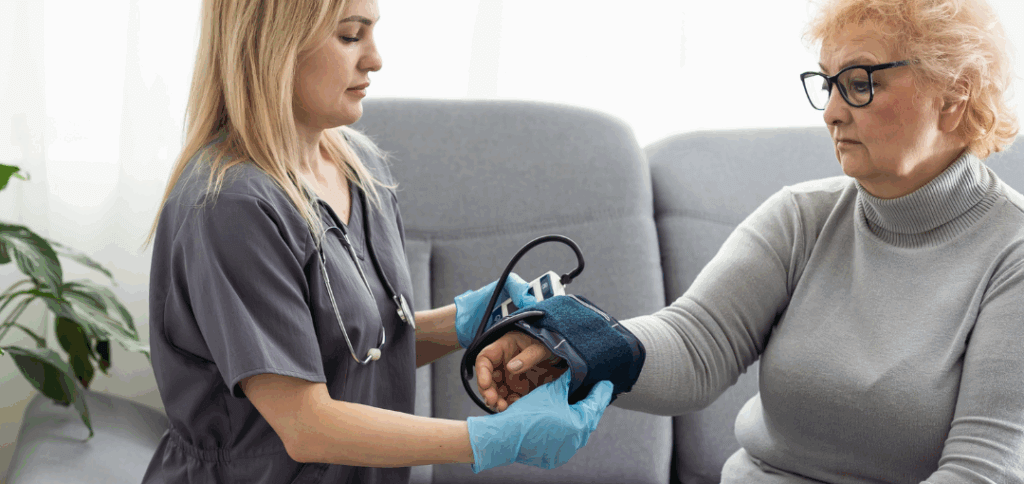Home care and hospice professionals dedicate themselves to looking after some of the most vulnerable members of our communities. But while they provide essential care to patients, they also face a unique set of risks on the job. From physical strain to exposure to infectious diseases, these health hazards can compromise not only worker wellbeing but also patient safety.
That’s why occupational health services are so critical in this space. By identifying and managing these risks early, providers can protect their workforce and maintain compliance.
Here are five of the most common health risks home care and hospice workers face and how occupational health and employee screening can help reduce them.
1. Infectious Disease Exposure
Whether it’s influenza, COVID-19, or tuberculosis, home care and hospice workers are regularly exposed to infectious diseases. Many patients have weakened immune systems, so even mild illnesses can pose serious risks. Regular TB testing, titers, and vaccinations offered as part of occupational health services are essential for early detection and prevention.
2. Musculoskeletal Injuries
Lifting and repositioning patients can put serious strain on the body. Repeated movements, poor posture, and lack of ergonomic support increase the risk of back injuries and other musculoskeletal issues. This is what makes pre-employment physicals a key part of employee screening, helping ensure staff are physically capable of handling the job’s demands.
3. Needle Stick and Sharps Injuries
Handling needles, lancets, and other sharps creates a constant risk of accidental injury and bloodborne infection. This makes these types of injuries high risk for all workers in hospice and home care workforces.
4. Undetected Hearing and Vision Issues
Clear vision and sharp hearing are critical for home care and hospice workers who need to stay alert in dynamic environments, communicate effectively with patients, and safely navigate homes. Undiagnosed issues can lead to miscommunication, safety hazards, and decreased quality of care. As part of Mobile Health’s occupational health services, hearing and vision screening can be included in your pre-employment and compliance exams to ensure your team is fully equipped to perform their duties safely and effectively.
5. Airborne Pathogens
Hospice and home care workers often rely on respirators to protect themselves from airborne pathogens. However, a poorly fitting respirator offers little to no protection. Respirator fit testing, part of our comprehensive occupational health services, ensures each employee’s mask fits securely and works effectively in real-world settings. Before any respirator fit test can be conducted, a medical evaluation must be completed first.
Frequently Asked Questions
What occupational risks should homecare employers monitor?
Employees should monitor risks like airborne pathogens, infectious disease exposure, and musculoskeletal injuries. From infection control to proper respirator use, each risk can affect both employee health and patient outcomes.
How can hospice employers reduce workplace injuries?
By partnering with Mobile Health, a provider that understands the unique demands of hospice care and simplifies the entire process. Our customizable employee screening and occupational health services help reduce injuries, ensure compliance, and keep your workforce safe.
Why are occupational health services important for home care and hospice workers?
Occupational health services help reduce the risk of illness and injury, ensure staff meet physical requirements, and keep your organization compliant with health regulations.
What should be included in an employee screening program for home care staff?
A complete employee screening program should include physicals, drug testing, TB screenings, vaccinations, and respirator fit testing, plus any additional requirements per the Department of Health and OSHA.
How quickly can results be returned from occupational health exams?
Mobile Health offers results in less than 48 hours on average, which helps speed up hiring and maintain consistent compliance.
Get Started with Mobile Health
With over four decades of experience and 6,500 clinic locations, Mobile Health helps employers meet their compliance needs without the headaches. Quick results, full-service employee screening, and expert support give you everything you need to keep your staff safe and your patients protected. Get started with Mobile Health.
-
 Written by:
Written by:
Tricia Chen-Weis, RNTricia Chen-Weis is a seasoned healthcare professional with a passion for operational excellence and patient care. Joining Mobile Health in August 2019, Tricia quickly made her mark improving patient care and clinical operations as Site Manager in Mobile Health’s 36th Street and Staten Island location. With a bachelor's degree from the University of The West Indies and a nursing degree from Monroe College, Tricia's educational foundation provided her with the knowledge and skills necessary to...
